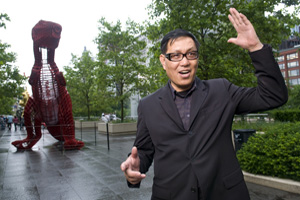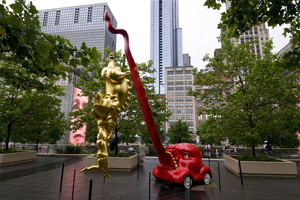Eastward bound
The University establishes a permanent center in China to expand its intellectual collaborations.
By Jason Kelly
Photography by Lloyd DeGrane
Dali Yang felt as if he’d gone on too long. Yang, who led the 2008 faculty committee that recommended establishing a University center in China, stopped himself after a few minutes of detailing the opportunities for the Beijing-based facility scheduled to open next fall.

Chicago art historian Wu Hung worked to bring Chinese art to Millennium Park.
“This is a little bit of a narrative,” he said. “Essentially we wanted a substantial physical presence that goes beyond study abroad, that truly elevates the intellectual exchanges between an American institution and Chinese institutions.”
The center will be the University’s fourth permanent foreign location, along with the Paris Center and Chicago Booth’s Singapore and London campuses. A faculty committee is exploring the possibility of establishing a presence in India.
In China, Chicago students and faculty have been doing substantial work for years. World Bank Chief Economist Justin Yifu Lin, PhD’86, one of the first Chinese nationals to earn a U.S. economics doctorate, served as a translator for Nobel laureate Theodore W. Schultz, who traveled to China in 1980 with a group of U.S. economists. Schultz’s Chicago colleague D. Gale Johnson led the effort to modernize the country’s economic scholarship. Lin has called Johnson “the father of modern economic research in China.”

Wu Hung cocurated A Conversation with Chicago, featuring Chinese artists.
Other University initiatives in China involve almost all disciplines. Yang’s committee surveyed the existing academic connections—including paleontologist Paul Sereno’s high-profile discoveries, art historian Wu Hung’s cultural exchanges, and a 20-page “incomplete compilation” of collaborations in the biological and physical sciences—and determined the extensive work justified a formal presence. “It was an eye-opening exercise” to see all the University’s China efforts collected in one place, said Yang, a political-science professor who also directs the Center for East Asian Studies. “Nobody truly had a grasp of all that was being done across divisions in that regard.”
Yet despite its existing collaborations, the University “has a relatively low profile” in the country, said Judith Farquhar, AM’75, AM’79, PhD’86, the anthropology department chair and an expert on contemporary China’s traditional medicine and popular culture. Establishing a physical center will encourage even more extensive research and collaborations, raise the University’s profile, and provide a place for Chicago alumni, students, and faculty to touch down and reach out.
“The center makes us much more visible,” Farquhar said. “And it’s planned that way with the physical location,” in the heart of Beijing’s university district, “and social relationships we want to develop.”
Chicago’s social relationships in China date back almost a century, including close ties to Peking Union Medical College. “The Rockefellers founded that college,” Yang said. “In fact, some of the University’s key medical-school staff members in the beginning came from PUMC. So there is a strong desire to enhance that relationship down the road as well.” The PUMC connection, Yang noted, would be an ideal platform for the University’s new Global Health Initiative (GHI) to enhance its China projects. In the country of 1.3 billion, the GHI will have numerous collaborative opportunities to study infectious diseases, nutrition, and environmental threats.
Many faculty members have already advanced medical research in China. Human genetics professor Bruce Lahn, for example, founded Sun-yat Sen University’s Center for Stem Cell Biology and Tissue Engineering, which his former postdoc Andy Peng Ziang now directs.
The faculty report called for programs that promote a “two-way exchange of knowledge,” which happens now mostly at the individual level. More than 200 Chinese students are enrolled at Chicago, making up the largest group of foreign advanced-degree candidates; the number of College applicants from China is increasing; and the East Asian Civilizations study-abroad program sends 25 undergrads to Beijing each fall quarter.
With Chicago’s contacts in China crossing so many divisions and demographics, the choice of the center’s location was based on keeping all options open. An official arrangement with a specific university, the faculty committee determined, might be constraining. “Because we want to be working with a range of Chinese institutions, we decided not to be formally on a campus,” Yang said. “It’s a little ambiguous in that regard.”
Ambiguous with its affiliations, perhaps, but for ambitious reasons. The center’s space, to be leased in Beijing’s Haidian District, home to scores of universities, puts Chicago “at the elite nexus of higher education in China, period,” Farquhar said, near Renmin, Beijing, and Tsinghua universities. From there faculty and students can collaborate with Chinese academics and research institutions and also extend their professional connections in the country.
“There are a lot of students, for example, who are interested in taking on internships,” Yang said. “Some of our peers already have staff in place in China to help their students to locate those kinds of internships. It’s very hard to do so from the home campus here. Of course, we do have some students go to China and do all sorts of activities, but generally speaking, it has been a limited effort, constrained by our lack of presence there.”
A veteran leader of the University’s efforts abroad will help establish that presence. Beth Bader, managing director of Chicago Booth’s Singapore campus for nine years, moved to Beijing in November to operate the China center. That the business school was “willing to give her up,” Yang said, illustrates the wide-ranging involvement the University plans in China. Business, economics, and policy will be one of three broad scholarship areas the center promotes. The others are science, medicine, and public health; and culture, society, and the arts.
Wu, a Beijing native, spent part of last summer in China, helping art critics devise critical standards for judging contemporary Chinese works. He also helped bring some of that art—including his friend Sui Jianguo’s Windy City Dinosaur, a looming red sculpture stamped “Made in China”—to Millennium Park for an exhibit on display through October 2010.
A “Chicago” dinosaur will be on display in Beijing too. Sereno agreed to provide a skeleton for the office, appropriate both as a literal connection to the University’s efforts in China and as a metaphor for the center’s ambitions. As Yang said, “The scale of what we’re trying to do is very special.”
Return to topWRITE THE EDITOR
E-MAIL THIS ARTICLE
SHARE THIS ARTICLE
ALSO IN CHICAGO JOURNAL
RELATED READING
- "Glimpses: Justin Yifu Lin, PhD’86"
(University of Chicago Magazine, Sept–Oct/09) - "Man-sized dinosaur was a tiny T. Rex"
(Live Science, September 17, 2009) - "Art scholar Wu Hung brings China’s bold aesthetic to Millennium Park"
(University of Chicago, Arts on Demand, Oct. 8, 2009)
